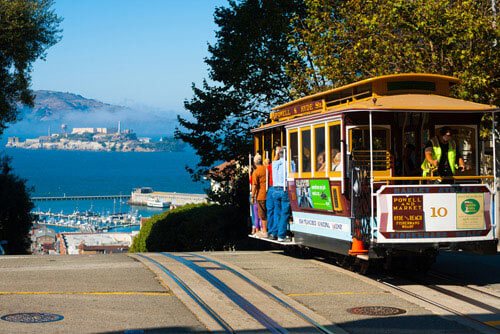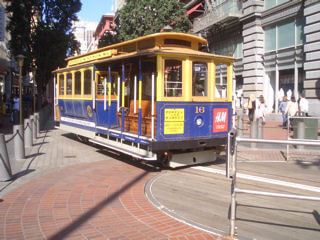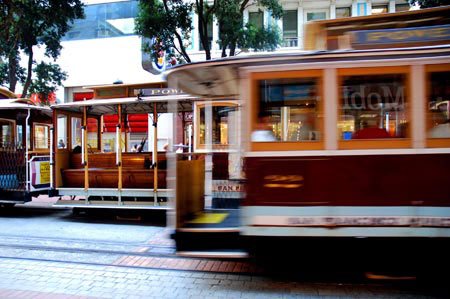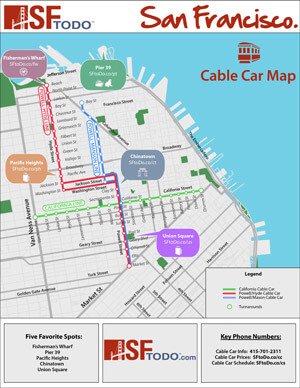San Francisco Cable Cars – The Guide.

Cable cars are a historic symbol recognized around the globe and offer real working transportation up the steep hills of San Francisco.
Cable Car Hours: 7:00 a.m. – 10:30 p.m. every day of the week (7 days a week) – Updated August 2022
You can download our printable cable car map, with all of the stops and top areas or a full San Francisco map. The (very popular) cable cars generally run about every 10 minutes.
From Union Square to the crest of Nob Hill, cable cars offer a thrilling way to move with the City. A ride on San Francisco’s cable cars may be the most iconic and memorable of your entire trip to California. Even people who might dismiss cable cars as a cheesy tourist attraction will admit that there is something incredibly romantic about these rides.
The current cable car fare (August 2022) is $8.00 and all fares are one way. There are discounted fares for seniors but only during non-peak hours. If you anticipate using the cable cars more than once in a day you should get a day pass which is $17.00. The all-day pass is also a good choice if you will be transferring from one line to another or if you will be transferring from a cable car to a MUNI bus (as no transfers are available for one-way fares).
Your one-way fare as well as your all-day passport can be purchased directly from the cable car operator on the car. The cable car operator can make change up to $20. Alternatively you can purchase your cable car tickets at the ticket booths that are located at the Powell/Market cable car turnaround, the San Francisco Convention & Visitors Bureau (also at Powell and Market) and the Hyde and Beach cable car turnaround. Unlimited cable car and bus / trolley rides together with museum passes can be purchased at a discount.
Insider Tips for Riding the Cable Cars
In addition to the tips provided throughout this article, here are some other insider things that will help you to enjoy the best ride possible on a San Francisco cable car:
- For the best views, you want to be on the side that faces the bay. That’s the eastern side of the Powell cars, meaning the right hand side for cars leaving from downtown and the left side for cars leaving from the Fisherman’s Wharf area.
- When you exit the cable car, wait for it to pass rather than crossing in front of it. The drivers are always paying attention but this is a heavy vehicle that can’t swerve to miss you so stay aware!
- Cable cars are sometimes late if it’s raining. It takes them longer to slow down when the tracks are wait. That’s just something to be aware of if you’re on a schedule.
- Even on warm days it can get chilly on the cable car as it gets moving up and down those hills. Bring a windbreaker.
- Put your belongings, such as bags and backpacks, on your lap or at your feet. They shouldn’t be hanging off of the car.
- Hang on tight. And watch your children. This is a form of transportation, not a ride, and you should treat it with that respect and safety in mind.

The Three Cable Car Routes
There are three different cable car routes to choose from in the city. The two main lines, Powell/Hyde and Powell/Mason, start off at the busy intersection of Powell and Market and vaguely make their way towards the popular destination of San Francisco’s Fisherman’s Wharf. These are the two lines that most visitors ride due both to their location and the fact that they climb some major steep hills and give those classic city views to the riders. The other San Francisco cable car route is the California/Van Ness line, which starts at California and Market and continues on until Van Ness.
Note: You can clearly see the exact routes for all of these cable car lines (and their relation to other major city attractions) on our free downloadable San Francisco city map.
Here is a look at some of the major highlights of each of the three lines:
- Powell/Hyde. The Powell/Hyde line actually ends up close to Ghirardelli Square where you can shop or eat; check out Ana Mandara, a Vietnamese restaurant that is owned by Don Johnson and Cheech Marin. Along the way you can exit the cable car at Lombard Street, famous for being “The world’s crookedest street.” If you aren’t going to Lombard Street then get your camera ready because at the top of this hill (Hyde and Lombard) you are treated to an unobstructed view of San Francisco’s Alcatraz Island. Across the street from the end of this line (at Hyde and Beach) is The Buena Vista Cafe, where legend has it that the Irish Coffee was born. If you don’t feel like shopping at Ghirardelli then you can visit the San Francisco Maritime Museum, the Hyde Street Pier, or just relax by the water and watch the boats go by.
- Powell/Mason. The Powell / Mason line also passes close to Lombard Street but it is at the base of the crooked street so the view you get is of the curvy street, similar to the postcard pictures you may have seen of this attraction. The Powell/Mason cable car line drops you off in North Beach, a quick walk to San Francisco’s Fisherman’s Wharf near Pier 39. If you’re hungry when you step off the cable car then head over to Kennedy’s Irish Pub and Curry House, a curious mixture of an Irish bar, a game arcade, and unbelievably delicious Indian food. Across the street from Kennedy’s is Bimbo’s 365 (at Columbus and Taylor), a music venue that is home to “Super Diamond,” a Neil Diamond cover-band. Alternatively you can walk down to the Wharf and get one of those famous San Francisco sourdough bread bowls.
- California/ Van Ness. This cable car rides through the hills of the Financial District and hits the top of Nob Hill where you’ll find luxury hotels and nightclubs with some of the most stunning views of the city. Go up to the 19th Floor of the InterContinental Mark Hopkins Hotel to the Top of the Mark and sip a martini while listening to some cool jazz. At Mason and California is San Francisco’s Fairmont Hotel, home to a great tiki-bar called The Tonga Room. Make sure to check out Grace Cathedral (at California and Taylor) if you like beautiful gothic architecture. Need a drink and want to play foosball? No problem, the Nob Hill Tavern is close by at California and Hyde Streets. You can also take in a movie at the Lumiere Theater (at Polk Street) or just walk around Polk and do some shopping. The cable car then makes its way down the hill to Van Ness Street where it stops and goes back the other direction. There is no turnaround for this line because the cable car has a grip at both ends of the car.
Fun Fact: The California Street cable cars are larger than the cars on the other lines. That’s because they are double-ended cars with an open section and a grip on either end while the other cars are single-ended cars.
The San Francisco transportation pass called The Clipper Card can also be used on MUNI whether you have a monthly pass or cash value on the card. Hand it to the cable car attendant and (s)he can scan it for you. Visitors can get a multi-day MUNI pass that includes cable car access (such as the MUNI and Cable Car 7 Day Passport).
How to Ride the Cable Cars
If you have never ridden a San Francisco cable car before then it can seem kind of confusing to navigate it at first. Don’t worry; it’s actually pretty straightforward once you know what you are doing.
Most visitors will get on the cable car at the beginning or end of the line and ride it all the way to the other end to get the most bang for their buck. There is a cable car turnaround at the intersection of Powell and Market Street near Union Square. The cable cars must be turned around because they only have one grip end with which to grab the cable. It is kind of neat to see the cars turn around here if it’s something you’ve never seen before. Here you can get in line to get on both the Powell/Hyde and Powell/Mason lines. Note that everyone gets in the same line. Look at the sign on the top of the cable car to see which one is about to leave. If the next car isn’t yours and you are next in line, just step to the side and let the people behind you pass. You’ll then be first in line for your car. During busy times, there is likely to be a very long line at this stop. However, the cars run every ten minutes or so and each car holds up 65 people so the line often moves more quickly than you’d expect.
TIP: If you want to avoid the long line then you can walk north a few blocks and get the car at the next stop. The downside to this is that the car will be almost full and you will most likely have to hang on to the side of the car to ride; the upside is that the wait is significantly shorter.
Although many people find it easiest to catch the cable car at the main turnaround, you are allowed to get on the car at any stop along the route. Simply wait at the stop, which is indicated by a brown and white sign that says MUNI Cable Car Stop and gives the line information. The car will stop for you and you can climb on. You do not need to wave it down.
You are allowed to sit in the outside seats or inside seats, stand in the inside section, stand on the back section or stand on the footstep area on either side of the car. In the latter case, you will need to hold on to the pole in front of you as you ride. If you are looking for the most adventurous ride then you’ll want to be in the front of the car, standing on the running board and hanging on to that pole. This is the best spot on San Francisco’s cable cars and sure beats being cooped up inside where you won’t see anything. Just make sure to scoot your boot when passing other cable cars and traffic; you don’t want to turn yourself into road-pizza because your caboose got clipped by a delivery truck.
Tip: It’s a lot warmer in that inside section so if you’re not trying to stake out a great view and just want to enjoy the ride in comfort then choose those inside seats.
Wherever you catch your ride and wherever you choose to sit, you should get fully onto the cable car and find your seat immediately, allowing others to get on as well. The attendant will then come around to see your ticket or collect your fare. Make life easier for everyone by having your ticket or fare money out and ready when he comes around.
There are no buttons to push or bells to ring to let the driver know that you want to get off of the cable car. On busy days, the cable car will stop at all of the stops along the route and you can just get off when it stops. The same is true if you are riding the car all the way until the end of the line. However, if it is a slow day, you may want to let the driver or attendant know what stop you want. You can tell them when you get on the ride or as the stop approaches. They’ll stop for you and you can be on your way.
Note: You can get exact information on where stops are located and the timetables of operation through SFMTA.
Cable Cars: Transportation vs. Tourist Attraction
Many people assume that the cable cars are just a ride that the tourists go on. While it is definitely one of the city’s major attractions, it is also a viable form of transportation and one that people who live in the city sometimes do use (although usually only in the offseason when the cars aren’t so jam-packed!) This is important to know even as a visitor because there are a few rare instances in which the cable car is actually quicker and more convenient than the bus system. For example, during peak hours in low-tourism seasons it can be faster to take a cable car to Chinatown than to take a bus. (Note, however, that it’s also more expensive!)
San Francisco Cable Car History
The San Francisco Cable Car system is the last working system of its kind in the world. The cable cars move by gripping an underground cable that is in constant motion, powered by an engine located in a central powerhouse. The “grip man” on board the cable car is responsible for operating the grip and ringing the bell. The car also has a conductor or attendant who takes the fare and helps keep an eye on everything for the grip man.
The cable car system in San Francisco was built in 1873. Local legend has it that Andrew Hallidie was inspired to build the cable car system when he witnessed some wagon horses fall to their deaths due to the steepness of Jackson Street. By 1890 it had nearly two dozen lines operating to get people all around the city. This system served as a model for similar systems in cities around the world. However, the system was short lived because electric streetcars were developed towards the end of the nineteenth century and provided a more efficient and cost-effective system of getting around. The final nail in the original cable car system was the 1906 earthquake, which damaged so much of the city’s existing infrastructure.
By 1912 only three cable car lines remained (and those only because they could get up the steepest streets that the electric streetcars couldn’t navigate). By the 1920s there were also buses as alternatives to these lines. However, some people did want to keep the historic cable cars running and there was a lot of debate about how to do so. Changes have been made to the lines over time but today the three main lines do continue to run. Learn more on cable car history here!
Fun Fact: The cable cars are the only mobile National Monument in the world, and are listed on the National Register of Historic Places.
Cable Car Special Events
If you’re lucky enough to be visiting during the month of July then you won’t want to miss the annual cable car bell ringing contests, which happen on either the second or third Thursday of the month. The contests are held in Union Square and draw thousands of spectators, both locals and visitors. Some of the grip men are extremely good at what they do and the applause that they receive can be thunderous with approval. Grab a hot dog and make a day of it; the event draws celebrities and local dignitaries like the Mayor of San Francisco so you know you’ll be in for a wild time.
Do you have your own special event in the city? You can actually charter a cable car for your group. Learn more at SFMTA.
Cable Car Museums
If you want to learn more about San Francisco cable cars then check out The Cable Car Museum at the corner of Mason St. and Washington St. This is a free museum that is open every day of the year except for the major holidays. You can see some of the historic cable cars, learn all about the different eras of the San Francisco cable car and see photographs of the cars in action. The neatest part, though, is that this is actually the powerhouse of the cable car system and you can see the huge engines at work as they pull the massive cables that run the cars.
Another free museum is the SF Railway Museum, which is located close to the San Francisco Ferry Building. This museum has information about the cable cars as well as the historic F-line trolleys in San Francisco. Learn all about the history of varied rail transit in the city through the exhibits at this museum, which is open Tuesdays through Sundays.
By Kathryn Vercillo, Copyright SFTravel LLC


